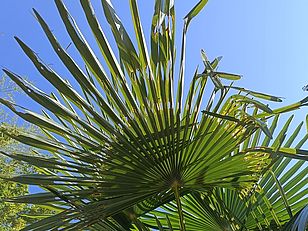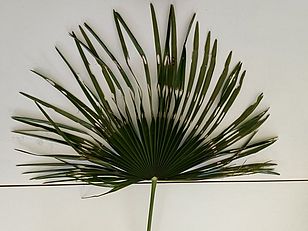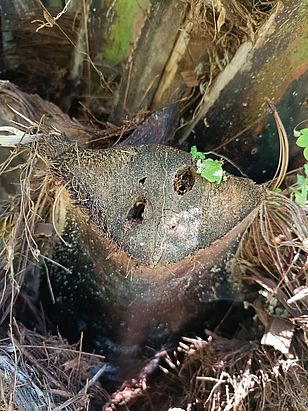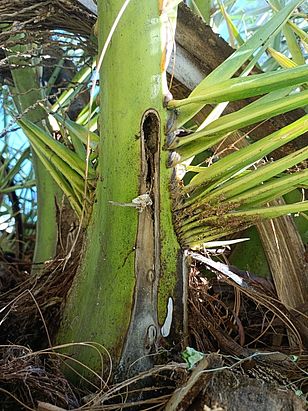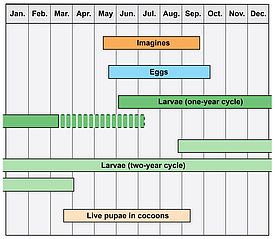
The palm moth in Ticino ¶
In summer 2023, the first sighting of the palm moth (Paysandisia archon) occurred in the Canton of Ticino, Switzerland. This moth, originally from South America, has been increasingly spotted in Southern Europe in recent years, where it poses a significant threat to palm trees .
The larvae of the palm moth bore into the heart of palms, feeding on the inner tissues, weakening the plants, and potentially leading to their demise. In Southern Europe, various cultivated ornamental palm species are being attacked, as well as populations of the European Fan Palm (Chamaerops humilis), which is native to the Mediterranean region and plays a vital role within its ecosystem.
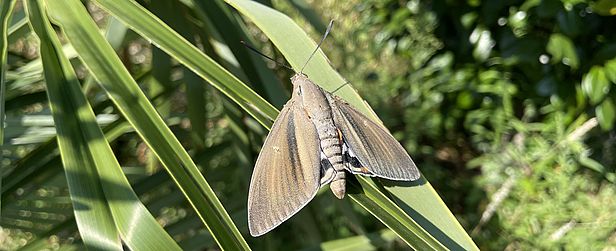
Situation in Ticino as of Summer 2023 ¶
Sightings of the palm moth in Ticino have been confirmed in Brissago, Ronco sopra Ascona, and Lugano. The relatively high local infestation rate in Brissago suggests that the moth most likely arrived already some years ago but remained undetected.
Introduction to the Canton of Ticino likely happened due to the introduction of infested ornamental palms and not by natural dispersion (flying moths) from neighbouring Italy. Among the affected palm species in these areas are the Chinese windmill palm (Trachycarpus fortunei), blue hesper palm (Brahea armata), European fan palm (C. humilis), and the Canary Island date palm (Phoenix canariensis). However, evidence from other regions suggest, that all palm species (with the exception of the dwarf palms of the genus Chamaedorea) that are climatically suited to Ticino, can be potential hosts of the palm moth.
This new occurrence of the palm moth raises questions about its potential impact in Ticino on ancient, cultivated palm specimens in gardens and public parks, as well as on the invasive Chinese Windmill Palm (T. fortunei) spreading in the peri-urban forests.
Identification of the palm moth and signs of attack ¶
Adult palm moth ¶
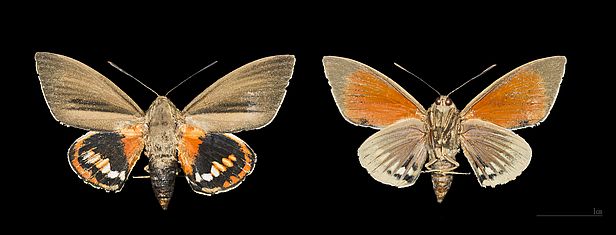
The adult palm moth can be easily identified due to its striking appearance, featuring a wingspan of 6 – 11 cm and distinctive brown coloration adorned with prominent white and orange spots
Foliage damage ¶
Check for leaves with regularly holed leave-segments as a consequence of the larval activity within the palm heart. Yellowing, browning and eventually wilting of palm fronds may be then a sign of an advanced palm moth attack.
Entry holes and sawdust-like material ¶
Inspect the upper part of the palm trunk for small entry holes and look for accumulations of sawdust-like material within leaf axils. This sawdust-like material is a byproduct of the palm moth larvae tunneling inside the palm.
Visible larvae or pupae ¶
In some cases, you may be able to spot the pale, segmented larvae or pupae of the palm moth within the palm's heart.
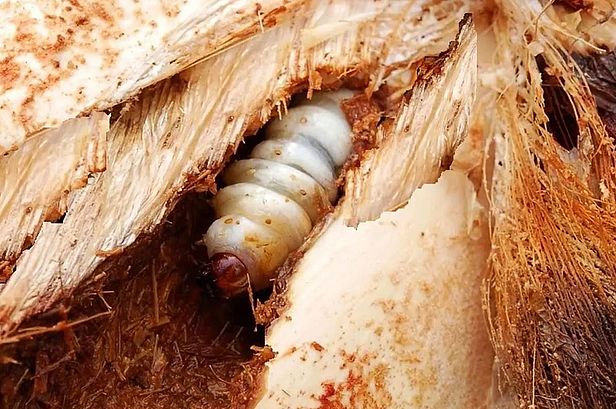
Dispersion of the palm moth ¶
The natural dispersion of the palm moth over short distances occurs by flying from one palm tree to another, especially during mating and egg-laying activities (usually from May to September). While this enables local spread, it is generally limited to relatively short distances. However, the primary means of long-distance dispersal is through human activities, particularly through the trade of ornamental palms.
Control methods ¶
The current goal should focus on slowing the palm moth's spread to safeguard non-invasive ornamental palm species, while we anticipate the development of promising techniques and products for controlling the invasive palm moth.
In the present situation of the Canton Ticino, the most promising control approach consists in removing the affected individuals. To this end, it is suggested that Fortune palms be felled promptly from the first symptoms of the insect's presence, and possibly also ornamental palms that are heavily attacked. After the palm has been felled, the apical part of the trunk (approx. 60 cm of the palm top) must be separated from the leaves and sealed inside a tightly closed bag to prevent the escape of larvae or adult butterflies. The material thus obtained must be safely disposed of at the cantonal waste incinerator (ICTR) by contacting the facility in advance.
Other possible treatments (presently not available for Switzerland):
Chemical control: Since the palm moth remains concealed within the host plant for an extended duration, endotherapy appears to be the most suitable approach for pest control, provided an effective compound can be identified. To control the palm moth, numerous compounds and treatments, including foliar sprays and stem injections, have undergone testing on palm trees. While some of these compounds have demonstrated promising outcomes, there are currently no commercially available products.
Biological control: Biological control is emerging as a promising alternative for managing infestations of the palm moth: Fungal-based biocontrol agents and nematodes (specifically Steinernema carpocapsae), and parasitoids like Trichogramma spp. have been so far explored as potential biocontrol agents, although further research is needed to determine their effectiveness and technical requirements.
In conclusion, there are currently no approved phytosanitary biological or synthetic products in Switzerland that have been proven efficient. This leaves only the possibility of mechanically removing infected palms. This is a simple measure that should make it possible to safeguard non-invasive ornamental palm species for as long as possible.
Life cyle of the palm moth Paysandisia archon ¶
The life cycle of the palm moth (Paysandisia archon) is closely tied to its host that are mainly palm trees. The larvae of this moth, which is the only stage causing plant damage, feed on plant tissues, particularly young leaves, and can also consume fruits and rachises. Their feeding habits severely harm the host plant, resulting in growth reduction, browning, and even death of leaves and offshoots. The larvae create galleries within the host plant stem, weakening it and allowing secondary pathogens to enter, eventually leading to the palm's demise. The complete larval development can take 10.5 to 18.5 months, depending on whether it follows an annual or biannual cycle.
When the larvae reach their 9th instar, they stop feeding and prepare a cocoon using palm fibers. Pupation lasts 35 to 68 days and the exuviates are usually found in the bases of leaves after metamorphosis. Adult Paysandisia archon moths are diurnal and fly during the sunniest hours of the day, avoiding temperatures below 22°C. Most adults become sexually mature three hours after emergence, with females exhibiting mostly monogamous behaviour. The moth's mate selection process is not mediated by sexual pheromones but instead relies on visual and short-distance chemical cues.
Females typically select a palm crown for oviposition, laying 1 to 10 eggs per event. The oviposition period takes place in the warmest hours of the day (corresponding to the tie span between 11:00 and 17:00 hours in Mediterranean environments) and lats four days starting from the day of mating, occurring between. The eggs have a distinctive rice-shaped appearance, are white-pink, and measure around 4 mm in length. They lack adhesive substances, so they are typically deposited close to each other and remain unfixed to the crown tissues or petioles. After 12-21 days, the larvae emerge.
